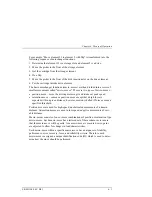
Chapter 6. Theory of Operation
EK–MOL80–SV. B01
6–13
Quick Exchange
A "quick exchange" is also possible when operating in dual-picker mode. A
quick exchange is just an exchange from one thumb of the picker, to the drive,
and then to the other thumb of the picker.
To do a quick exchange, the driver in the host has to be smart enough to see an
"exchange sequence" coming up and issue serial commands in an order that
minimizes the drive downtime.
The driver must get the source cartridge into the picker, and, while still allowing
processes to access the drive, move the picker to the drive.
After the picker arrives in front of the drive, an Exchange command must be sent
that takes the cartridge from the drive into the empty thumb, and then inserts the
new disk into the drive from the other thumb.
Then the drive is spun up. After the drive is spun up, the disk in the picker may
either be returned to its home slot or retained in the picker for the next exchange.
Below is a detailed description of this type of exchange.
1. Move to the source slot.
2. Grab the cartridge from slot.
3. Move to the drive.
4. Eject the cartridge from the drive (spindown).
5. Grab the cartridge (destl) from the drive.
6. Insert the cartridge (source) into the drive.
7. Spinup the drive.
8. Move to the home slot(dest2).
9. Put the cartridge into the home slot.
The quick exchange is performed by executing the following sequence:
1. Move from source to pickerl.
Position to element destl(the drive).
2. Exchange picker_thumb1 desti picker_thumb2.
3. Move from picker2 to dest2.
The drive exchange time is the time it takes to execute steps 4 through 6. This
does not include the time to get the source cartridge, or put away the dest2
cartridge.
The drive down time is the time it takes to execute steps 4 through 7, waiting for
the drive to spin up. The drive's downtime is mainly a function of the drive's
spinup/spindown time. This type of exchange is useful only on drives with short
spinup/spindown times.
















































